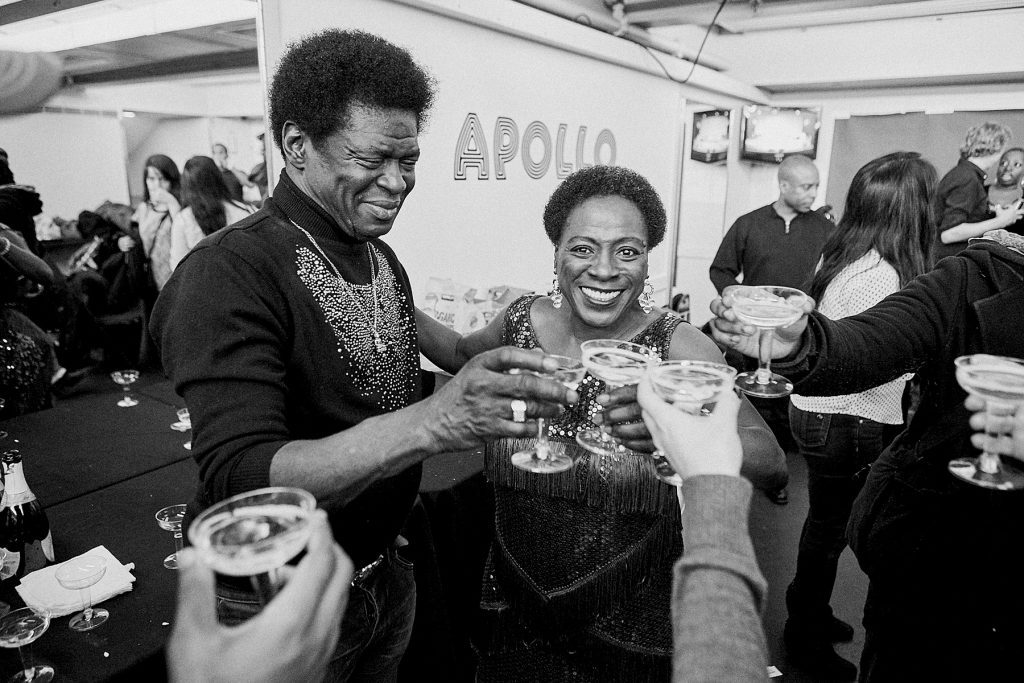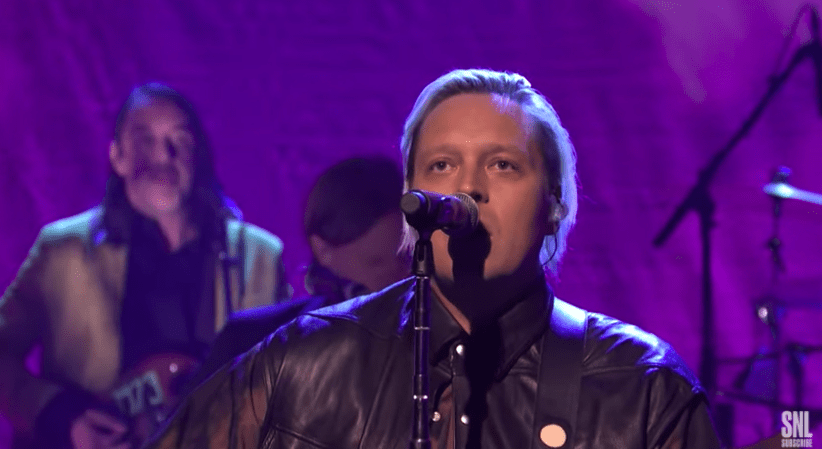
Revisiting Daptone Records’ Halcyon Moment at the Apollo
There wasn’t a dry champagne flute at the Apollo Theater. On December 5th, 2014, Daptone Records’ Super Soul Revue had gathered most of the Brooklyn-based independent label’s acts together for the second of three nights in Harlem. The vibe was that of a rowdy family reunion, starting the moment the musicians loaded in the the day before. In one corner, Sharon Jones, the sprightly 58-year-old lead singer of the Dap-Kings, was jitterbugging in slippers while cracking up anyone within earshot; in another, Charles Bradley, fragrant with the scent of the palo santo he’d just lit, was stopping to embrace whomever he encountered in the sidestage shadows. Someone from Afrobeat ensemble Antibalas puffed on a vape pen, filling the staircase leading up to to the lofty dressing rooms with clouds, and sending members of the Menahan Street Band into knowing headshakes and giggles.
Earlier that day, Jones and the Dap-Kings had received the exciting news that Give the People What They Want — their fifth album, which they’d released that January and spent the last 10 months touring behind — was nominated for Best R&B Album at the 57th annual Grammy Awards. This was a significant milestone, a first for both band and label, and a special triumph for Jones, who had been diagnosed with bile duct cancer the year before. Her illness and treatment had delayed the release of Give the People What They Want, but Jones and the Dap-Kings prevailed. She began 2014 by kicking off her shoes and bellowing through “Retreat!,” the album’s lead single, at its release show in New York City, and now she was closing out the year here at Harlem’s temple of soul, where James Brown, Aretha Franklin, and generations of soul and R&B greats had come before her. The fear, uncertainty, frustration, and pain that had defined those hard months after her diagnosis dissolved backstage as her band and labelmates raised their glasses in her honor.
blogherads.adq.push(function () {
blogherads
.defineSlot( ‘medrec’, ‘gpt-dsk-tab-article-inbody1-uid0’ )
.setTargeting( ‘pos’, [“mid-article”,”mid”,”in-article1″,”mid-article1″] )
.setSubAdUnitPath(“music//article//inbody1”)
.addSize([[300,250],[620,350],[2,2],[3,3],[2,4],[4,2]])
;
});
“It just felt like we couldn’t get any higher,” remembers Gabe Roth, the co-founder of Daptone and the Dap-Kings’ bandleader and bassist. “To see her so excited, everybody flipping out — all the champagne came out, everybody toasting — she was so happy.”
Jones’ joy is palpable in a snapshot of the toast that’s included in the hefty photo booklet that accompanies The Daptone Super Soul Revue Live! at the Apollo, due out October 1st. The 32-track album, compiled from nearly 12 hours of music that Roth painstakingly recorded and produced, captures every bluesy breakdown, brassy flourish, and lung-busting performance from the superlative musicians who branch out from Daptone’s family tree.
Many of these artists were friends and collaborators even before the label’s inception. When he met Jones in the late Nineties, Roth was running an obscure label whose catalog included a soundtrack for an imaginary martial-arts film. He, Daptone co-founder and saxophonist Neal Sugarman, and several of their bandmates traded places in various groups in the years leading up to 2002’s Dap-Dippin’ with the Dap-Kings, their debut album with Jones and Daptone’s first official LP. The band — a wildly talented group that also counted trumpet player Dave Guy, organist and producer Victor “Ticklah” Axelrod, drummer Homer Steinwess, percussionist Fernando Velez, guitarist and MC Binky Griptite, guitarist Tom Brenneck, backing vocalists Saundra Williams and Starr Duncan, and more as members — had built a faithful fan base in New York and abroad by the mid-2000s, when they caught the attention of producer Mark Ronson, who thought they’d be the perfect backing band for the rising English neo-soul singer he was working with. Their collaboration on Amy Winehouse’s 2006 LP Back to Black officially introduced the Daptone sound to the mainstream, but the Dap-Kings were focused on their own projects. They headlined the Apollo for the first time around the release of Jones’ 100 Days, 100 Nights in 2007, and they spent summers perfecting the early incarnations of the Super Soul Revue.
blogherads.adq.push(function () {
blogherads
.defineSlot( ‘medrec’, ‘gpt-dsk-tab-article-inbody2-uid1’ )
.setTargeting( ‘pos’, [“mid-article2″,”mid”,”in-article2″,”mid-article”] )
.setSubAdUnitPath(“music//article//inbody2”)
.addSize([[300,250],[300,251],[620,350],[2,4],[4,2],[3,3]])
.setLazyLoadMultiplier(2)
;
});
“From the beginning, we had the idea of putting on this seamless show,” Roth says. “There are a lot of labels who have a great group of artists that could do a set, and then turn off the house music, let the techies come out and move the drum set, and bring out a different artist — but that’s not what we were doing. We had two drum sets. The musicians were coming on and off, backing each other up, playing interludes from one to another. That kind of fluid show can only happen when you have a family of musicians that are used to playing with each other, that know each other’s music, that are all friends and used to working together musically.”
Modeled after the ones that Stax and Motown took on tour throughout the Sixties and Seventies, these stacked label showcases became a favorite fixture on the international festival circuit from Austin to Amsterdam. Live! at the Apollo is the only live full-length in Daptone’s catalog, and the sole document of this key aspect of the label’s identity.
It is also an undertaking Roth had been dreading for years, putting it off until the pandemic left him without other projects to focus on. “I’ll be honest with you: It was a fuckin’ nightmare,” he says. “It was the hardest thing I ever did. At first I thought it was hard because of the scale of it. It was 11 or 12 hours of music. There were 70 different tracks, microphones in the audience, and all these different bands.”
In the eight months he spent finalizing Live! at the Apollo, though, he found that the logistical challenges were nothing compared to the emotional ones. “I started realizing towards the end,” he says. “It was so hard to work on because so many of my friends were dead.”

Isaac Sterling*
The losses that followed that triumphant night at the Apollo were staggering. Jones’ cancer returned in 2015, and she died the next year. Bradley was diagnosed with stomach cancer in 2016, and he died in 2017. Cliff Driver, the legendary organist and bandleader of Naomi Shelton and the Gospel Queens, passed in 2016, and Shelton died earlier this year — merely hours after Roth finished mixing the recording of her Apollo set.
While Roth has worked on posthumous projects for Jones and the Dap-Kings (2017’s Soul of a Woman) and Bradley (2018’s Black Velvet, which was produced by Brenneck, his protégé and Bradley’s chief collaborator), those experiences only magnified the gravity of the task at hand when he revisited the tapes for Live! at the Apollo, whose release will usher in celebrations for Daptone’s 20th anniversary in the coming year. It wasn’t the music that got to him, so much as the intimacies and pleasantries woven throughout the live show, moments that felt unique to the Super Soul Revue and the people he loved.
blogherads.adq.push(function () {
blogherads
.defineSlot( ‘medrec’, ‘gpt-dsk-tab-inbodyX-uid2’ )
.setTargeting( ‘pos’, [“mid”,”mid-articleX”,”in-articleX”,”mid-article”] )
.setSubAdUnitPath(“music//article//inbodyX”)
.addSize([[300,250],[300,251],[3,3],[620,350]])
.setLazyLoadMultiplier(2)
;
});
“Sitting there with headphones on late at night, hearing the stuff Sharon would say in between songs, it was visceral. It made me feel like I was still standing behind her onstage,” Roth says. “That’s what I wanted to do for everybody else: to transport them back in time for a second, to being at those shows.”
For Brenneck, who played with the Dap-Kings before forming the Budos Band and the Menahan Street Band, Live! at the Apollo achieves what the other records in Daptone’s catalogue do not, in that it elevates the imperfections and improvisations that made the gigs such memorable spectacles.
“It’s a time capsule of Daptone at its peak,” he says. “Charles and Sharon and the Dap-Kings and Antibalas, they were touring bands, known for their energetic live shows. None of that is ever captured on record.”
When choosing what to keep for the record, Roth prioritized the kinds of ephemeral moments that echo through a venue but usually stay there. “I’m used to having a lot of control over the arrangement and the performance,” he explains. “It’s not just me having control, but the musicians having control, the artists, everybody trying to get everything just right. This record was not like that. It was all about capturing the energy in the room.”
Binky Griptite, the Dap-Kings’ guitarist and smooth-talking master of ceremonies, introduced every single act at the Apollo. Roth could have squeezed another song onto the album if he cut Binky’s narration, but it set the jubilant tone of the project. When the Como Mamas’ Della Daniels greeted the crowd with a raspy, triumphant “APOLLOOOO!,” that exclamation was as important to include as the song that followed. Williams and Duncan, the Dap-Kings’ backing vocalists, released their own album as Saun & Starr in 2015; Roth rolled with the unreleased “Confess It,” savoring a track he loved but that didn’t quite work in the studio. In lieu of selecting “Retreat!,” “100 Days, 100 Nights,” or other Dap-Kings mainstays, he went with “Calamity,” a standalone 2014 single, and a riotous rendition of “Get Up, Get Out” that smokes the buttoned-up take from Give the People What They Want.
blogherads.adq.push(function () {
blogherads
.defineSlot( ‘medrec’, ‘gpt-dsk-tab-inbodyX-uid3’ )
.setTargeting( ‘pos’, [“mid”,”mid-articleX”,”in-articleX”,”mid-article”] )
.setSubAdUnitPath(“music//article//inbodyX”)
.addSize([[300,250],[300,251],[3,3],[620,350]])
.setLazyLoadMultiplier(2)
;
});
A cover version of James Brown’s “There Was a Time” is the undeniable standout track of Live! at the Apollo. Many of Daptone’s artists grew up worshiping Brown and working towards a moment like this on the Apollo’s stage. Jones, a fellow Augusta, Georgia native, was a lifelong fan; Bradley built a following as a James Brown impersonator before recording under his own name; Saun & Starr used to sing back-up for the artists who’d roll through the Apollo’s famed Amateur Night showcase. “There Was a Time” invokes the history of the Apollo while highlighting Daptone’s place within it. Jones declares that she’ll do the song “my way, not James Brown’s way!” before launching into a frenzied dance-off with Bradley, Duke Amayo of Antibalas, and any other member of the Daptone family who dared to join her.

The Budos Band onstage at the Apollo
Isaac Sterling*
Roth highlights the influence of Brown’s classic 1963 Live at the Apollo, regularly cited as one of the greatest albums ever made: “This was somebody at the peak of their career choosing to do a live record instead of a studio record. The way I always heard it was that the label didn’t want to do it, and he financed it himself, so it was also an act of power — of Black power and independent power. For me and for Sharon and for all of us, James Brown was the beginning and the end: probably the greatest live band, ever, and the biggest inspiration as far as trying to put the showmanship and energy and rhythm into a performance, and to really get the room that hot. We’ve been playing ‘There Was A Time’ for years and years. She didn’t do it like James Brown, but she had the energy to it. There’s something about the fire in it and just how hard she would dance and how hard the band was playing. … It was a climax of the show, and it was the climax of an incredible career for Sharon.”
Though Daptone’s Live! at the Apollo was a true labor of love to put together, Roth and Brenneck feel it’s the most appropriate tribute they could give to their late friends, highlighting their love for the music and their need to sing it in its raw, true form. It’s the closest thing to a family album Daptone will ever make.
“They really had no interest in settling down — they lived for that performance,” Brenneck says of Bradley and Jones. “The two of them were fighting cancer, and their eyes were on the prize. They wanted to get back out on the road. If we were like, ‘Charles, oh my God, I think you should rest more,’ he just wanted to go. With Sharon, nobody could tell her no. If she wanted to do it, man, there’s a certain point where you just have to be supportive as a friend, even if you disagree with it. It’s like, ‘Goddamn, I don’t want you to do this, but if you’re going to do this, we’re going to be right there with you.’”
blogherads.adq.push(function () {
blogherads
.defineSlot( ‘medrec’, ‘gpt-dsk-tab-inbodyX-uid4’ )
.setTargeting( ‘pos’, [“mid”,”mid-articleX”,”in-articleX”,”mid-article”] )
.setSubAdUnitPath(“music//article//inbodyX”)
.addSize([[300,250],[300,251],[3,3],[620,350]])
.setLazyLoadMultiplier(2)
;
});
Roth agrees. “As much as I complain about how hard it is to work on this stuff, and how sad it is to have lost those people, it’s not unfortunate to do this tribute — it’s very joyous,” he says. “Unfortunate would’ve been if all those people died before we made those records, before we could’ve done those tours, before we could’ve had those laughs and done those shows. To me, it’s a real celebration of the first 20 years of what this family of musicians was able to accomplish.”




